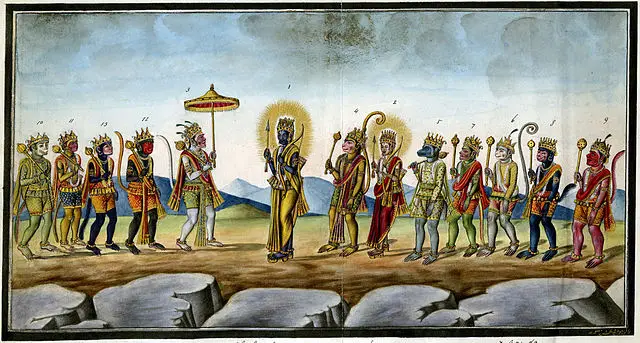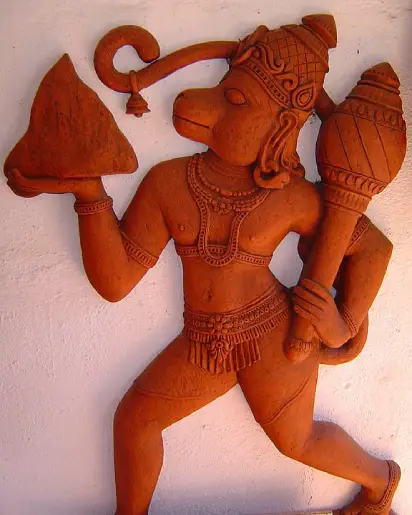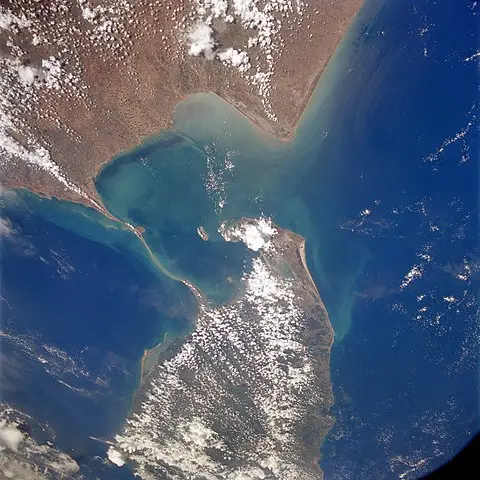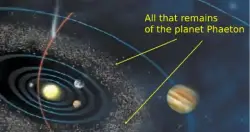The civilization of humanoid monkeys "Vanara" built a bridge across the ocean 18,000 years ago?
The civilization of humanoid monkeys "Vanara" built a bridge across the ocean 18,000 years ago?
The ancient Indian epics "Ramayana" and "Mahabharata" contain information about the mysterious civilization of intelligent monkeys, known as "vanaras", who lived in deep, warm forests and lush jungles. The existence of such species has always caused controversy among scientists who believe that they can be mistaken for people of the tribe. But ancient texts and writings vividly describe their ape-like characteristics, such as jumping, fur, fur and tails.

In the Ramayana, a whole army of half-humans and half-monkeys played a key role. They fought together with Rama to defeat the Sri Lankan demon king Ravan and rescue his wife Sita from captivity. The word vanara itself comes from two Sanskrit words: vana ("forest") and nara ("man"), which means "forest man" or "forest dweller".
In addition, it was said that the Vanaras had strength and agility that surpassed the strength and agility of an ordinary person, and this was one of the reasons why they were able to resist the demonic armies of Lanka. It was believed that some Vanaras were direct descendants of the gods.
For example, the most famous and powerful of the Vanaras, the God Hanuman, was the son of the wind god Vayu, the main Hindu deity, and, as is known, he himself showed godlike abilities. In fact, he appears in another Indian epic, The Mahabharata, which takes place thousands of years later, which implies his immortality.

The scholar B Vijayashri in his journal "The Journey of the Tail from Treta Yuga to Dvapara Yuga" mentioned that Hanuman blocked the path of Bhima (a powerful character of the Mahabharata) in the Gandhamadan mountains in the Himalayas.
According to the Ramayana, when Sita was abducted by the 10-headed demon king Ravana, Rama gathered an army of Vanara. It turned out that Sita was in captivity on the island of Lanka. Rama, unable to ferry his huge ape-man forces across the ocean, received the advice of the sea god to build a bridge across the water. For its construction, Rama enlisted the help of the Vanaras.
The Vanaras built a bridge between the mainland and Lanka, building it out of stones and boulders, which, according to the description, resembled mountains. It is believed that the construction lasted five days, and its length was 100 leagues. Once completed, the bridge allowed Rama to ferry his Vanara army across the ocean to Lanka. There Ravana was killed and Sita, the wife of Rama, was saved.
This bridge, known as Ram Setu (Adam's Bridge), was just a myth before the appearance of NASA images. The exact age of the bridge is difficult to determine. According to the Ramayana, his age is estimated at 1.7 million years, while some studies claim that he is only 18,400 years old.

The Adam's Bridge as seen between India and Sri Lanka, from Space Shuttle Endeavour during STS-59. National Aeronautics & Space Administration
Dr. Badrinarayanan, former director of the Geological Survey of India, conducted a study of this structure and came to the conclusion that it was created by man. He and his team drilled 10 wells along the Adam Bridge line. What he found was amazing. At a depth of about 6 meters, he found a layer of calcareous sandstone, corals and materials similar to boulders. His team was surprised when they found a layer of loose sand, about 4-5 meters below, and then solid rock formations under it.
Since we have physical evidence of one of the Ramayana incidents in which the Vanaras participated, could they have been our earliest ancestors? Maybe thousands of years ago, some other kind of hominid lived on the Indian peninsula? It is quite possible.
About 2.5 million years ago (shortly before the beginning of the Treta Yuga), human evolution made a big leap with the appearance of the genus "Homo". Homo habilis were the first group of primates capable of using tools. Approximately 1.8 million years ago, Homo erectus and Homo ergaster debuted. Homo ergaster lived mainly in Africa, and Homo erectus - in Eurasia. Studies of these two species show that Homo ergaster had a smaller skull volume, and its cousin Homo erectus had a larger one. Studies of the skeletal structure of Homo erectus show that Homo erectus was strong, which suggests that they were stronger than modern humans
Ancient Origin writes:
The mystery of the Vanara civilization has not yet been solved, but researchers can already affirmatively state that a civilization of intelligent monkeys once lived on the planet. We would also like to draw your attention to the fact that the Gods themselves, described in the epic, definitely use uncharacteristic weapons and equipment. And the construction of the bridge itself in 5 days is so long? In your opinion, this is done only with a pick and shovel? Who are they? Those who lived before us? Or aliens? Where did they go? Questions that we have yet to answer. Stay with us and you will definitely learn more!
About author:
Serg Toporkov Ufologist, Ph.D., blogger, I go on my own expeditions for UFOs. I use scientific methods to investigate the UAP phenomenon. Write to me |
Related tags:
Vanara humanoid ape aliens India Adam Bridge Rama Sita Ravana Mahabharata ancient civilizationsRandom UFO or conspiracy article
The Phaeton Death Mystery
 Even in ancient times, astronomers were surprised by the unnaturally huge distance between Mars and Jupiter. Many scientists agreed that there should be another planet in this place. But they could not find it in any way.
Even in ancient times, astronomers were surprised by the unnaturally huge distance between Mars and Jupiter. Many scientists agreed that there should be another planet in this place. But they could not find it in any way.
